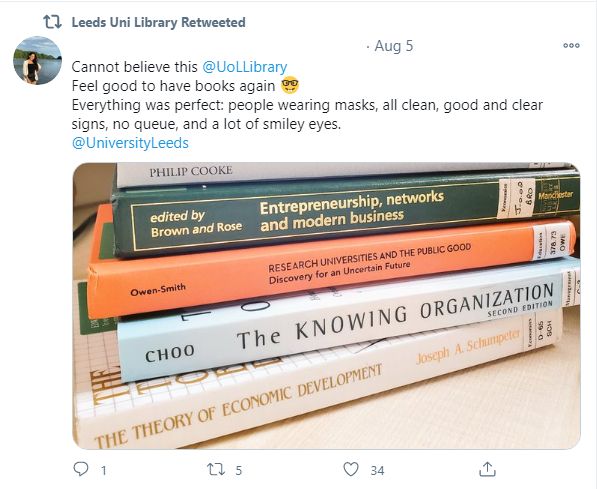Annual report 2019-20
Covid-19 response
On this page:
- Switch to online book provision
- Online enquiries
- Making Covid-19 research easier to find
- Click-and-collect service
- Study space preparation
Our Customer Service Team made us proud with their professional and dedicated response to closing the physical library at the start of lockdown, and with the work and care brought to reopening. They went the extra mile to try to make sure that staff and students received last-minute requests for books in the days before lockdown, and to reinvent the library service to re-open for click-and-collect and socially-distanced study.
Less visible but just as determined, Collection Services stepped up not just to keep services running, but to create new services and resources to support online learning, exams and Covid-19 research.
Switch to online book provision
When we locked the doors to our buildings, our first thoughts focussed on how to support our students with end of term assignments and exam revision. Our mission was to increase and upgrade access wherever we could.
We worked with departments and tutors to identify texts needed for open book exams. This was hugely important as restrictions on concurrent use of ebooks would have meant that not all students could access a text at the same time during the exams.
There was also a 30% increase in the number of reading lists we received for semester 1 and we changed our processes to meet demand.
To make more recommended reading material available online, we:
- analysed our collection data to find high use titles, actively sought to convert print-only to electronic format, and upgraded existing online access
- worked intensively with existing and new suppliers to provide new access to textbooks and other online media; this included individual negotiations for over 250 core texts previously unavailable online
- upgraded our existing online licences to increase access and reduce the number of turnaways
- changed our processes and workflows to include auto-upgrades, auto-purchases and patron driven acquisition
- capitalised on changes made to copyright licensing terms to digitise even more online course readings (for when an ebook of a core text is unavailable).
The result of this intense ongoing work is a better online reading experience and much improved access to online materials for students.
Online enquiries
Online enquiries through email, the website and web chat continued seamlessly seven days a week. Frontline staff worked from home, many with less-than-ideal personal devices initially. We saw that webchat became more popular as lockdown continued, with a 36% increase over last year between March to August.
Our primary focus was to continue to support final year students who were sitting exams and completing dissertations in April and May, and Masters students completing over the summer period. This support is not just troubleshooting—as an accessible, supportive and neutral service, it is also pastoral and pan-service, offering reassurance and signposting to other services.
Making Covid-19 research easier to find
From March 2020, research into Covid-19 was underway around the world with rapid publication of findings.
Searching for published research takes time. The publishers helped by creating collections of their own content, but these collections exist independently.
We used one of the features of our new library management system to create a collection to bring these disparate sources together, making them more easily discoverable through Library Search.
By providing a single location with access to many resources, we reduced the amount of time needed to find the content.
Click-and-collect service
At the end of July we were able to gain safe access to library buildings for library staff, who were met with a mountain of books to return. We returned 7,997 items by the end of August.
We designed a new system and processes so that our print collections could be safely used again. Our click-and-collect service allows users to request print material from the Library Search item record. Library staff on campus pick up the material and make it available to collect, normally within a 48-hour turnaround.
Demand from researchers who had been deprived of access to print texts was high, and we completed 1,550 click and collect requests by the end of August. It was warmly welcomed by staff and students.

Study space preparation
Our plans to reopen study space, contact free and Covid-secure, started in May and came to fruition in September in preparation for the start of term.
Our approach to reopening campus-based services was to prioritise the safety of our staff and our students, and to respond to changing circumstances and adapt to demand.
The starting point was to tightly control footfall and social distancing within buildings, and to avoid queueing outside buildings. This meant creating a way to book sessions and allocate seats. We worked to open one library at a time, and then increased the study space available at each site.
Social distancing reduces our capacity significantly to around 20-25% of our total number of seats. Although overall campus footfall was low, demand for library spaces was high with most study sessions fully booked. However, with multiple sessions available to book per day, we are maximising the use of this limited but essential study space.

